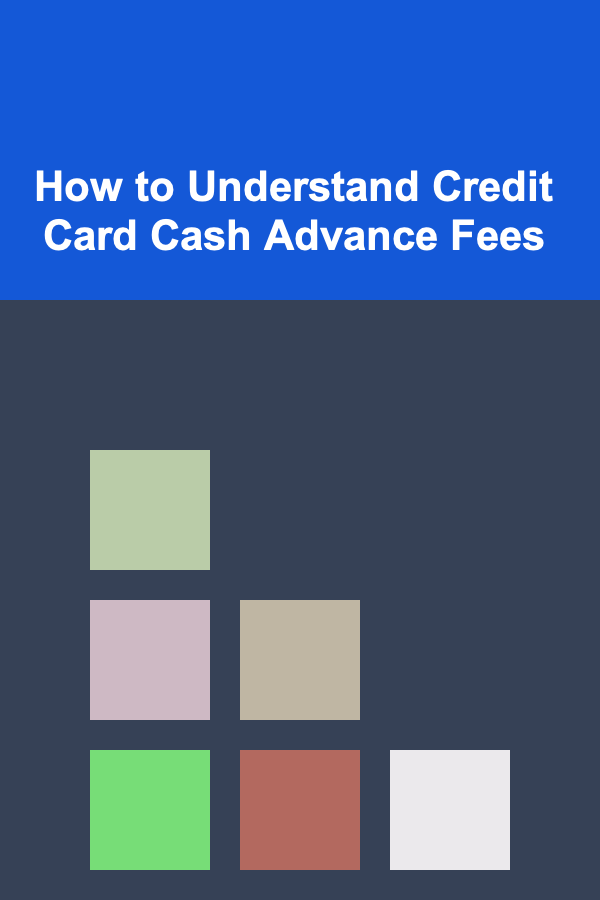
How to Understand Credit Card Cash Advance Fees
ebook include PDF & Audio bundle (Micro Guide)
$12.99$10.99
Limited Time Offer! Order within the next:

Credit cards are an essential part of modern finance, providing a convenient way to pay for goods and services, as well as offering various financial benefits like reward points and cashback. However, one of the lesser-understood features of credit cards is the cash advance. While cash advances can be a lifesaver in emergency situations, they come with significant fees and interest rates that can make them an expensive option if not carefully managed. In this article, we will explore credit card cash advances in depth, focusing on how they work, the associated fees, and how to avoid pitfalls.
What is a Credit Card Cash Advance?
A credit card cash advance allows you to withdraw cash from your credit card account, typically from an ATM or by requesting a cashier at a bank or credit card issuer. Unlike a regular purchase, which is subject to standard credit card interest rates and grace periods, cash advances are subject to different terms and conditions. They can be useful in urgent situations when you need quick access to cash, but understanding the costs involved is crucial before using this feature.
1.1 How to Obtain a Cash Advance
Obtaining a cash advance is relatively simple. You can:
- ATM Withdrawal: Use your credit card at an ATM to withdraw cash, just as you would with a debit card. This option typically requires you to know your credit card PIN.
- Bank or Issuer Office: Visit your bank or credit card issuer's branch and request a cash advance over the counter.
- Checks: Some credit cards provide convenience checks that allow you to draw cash against your credit limit.
- Online Transfers: Some credit card companies allow you to transfer funds directly to your checking or savings account.
Cash Advance Fees
Understanding the fees associated with cash advances is crucial because they are often higher than other credit card fees. These fees can vary depending on your credit card issuer and your specific credit card terms. However, there are several common types of fees that you should be aware of.
2.1 Cash Advance Fee
The most straightforward fee associated with a cash advance is the cash advance fee, which is usually a percentage of the amount withdrawn. This percentage can range from 3% to 5%, but some cards might have a flat fee instead. For example, if you take out $500 and the fee is 5%, you would pay a $25 fee on top of the cash advance amount.
- Example :
- Amount of cash advance: $500
- Cash advance fee: 5% of $500 = $25
- Total amount owed: $500 + $25 = $525
If your credit card issuer charges a flat fee, it could be something like $10 or $15 for any cash advance, regardless of the amount you withdraw.
2.2 ATM Fees
In addition to the cash advance fee, if you withdraw cash from an ATM that does not belong to your credit card issuer's network, you may be charged an additional ATM fee. These fees can range from $2 to $5 per transaction, and if you're withdrawing from an out-of-network ATM abroad, they may be even higher.
- Example :
- Cash advance fee: $25
- ATM fee (out-of-network): $3
- Total fees: $28
2.3 Foreign Transaction Fees
If you are traveling abroad and decide to take a cash advance, there is often a foreign transaction fee to consider. This fee typically ranges from 1% to 3% of the transaction amount and is applied when you use your card in a foreign currency.
- Example :
- Amount of cash advance: €200 (converted to USD as $220)
- Foreign transaction fee: 3% of $220 = $6.60
- Total fees: $25 (cash advance fee) + $6.60 (foreign transaction fee) = $31.60
2.4 Interest Charges
One of the most significant costs of a cash advance is the interest rate. Credit card cash advances typically have a higher interest rate than regular purchases. While typical credit card purchases might carry an APR of 15% to 25%, cash advances can have APRs of 25% to 30% or more. Furthermore, interest on cash advances begins accruing immediately, unlike purchases, which often have a grace period.
This means that if you take a cash advance, you'll start paying interest right away on the amount you withdrew, and the high-interest rate can quickly accumulate.
- Example :
- Cash advance amount: $500
- APR for cash advances: 28%
- Daily interest: 28% / 365 = 0.0767% per day
- Interest on $500 after 1 day: $500 * 0.0767% = $0.38
- After 30 days: $500 * 28% = $140 in interest if the balance isn't paid off.
How Cash Advance Interest Works
The interest on cash advances can be tricky because, unlike regular purchases that might have a grace period, interest on cash advances starts accumulating as soon as you take the money out. Furthermore, if you carry an outstanding balance on your credit card, your credit card issuer may apply your monthly payment to the lower-interest balances first, meaning your cash advance balance may continue to accrue interest even as you make regular payments.
3.1 No Grace Period
Most credit cards do not offer a grace period for cash advances. While a regular purchase might give you 21 to 30 days to pay off the balance before interest kicks in, a cash advance will begin accruing interest immediately.
3.2 Compounding Interest
In some cases, the interest charged on cash advances can compound daily, which means that you're paying interest on both the amount borrowed and the interest already accrued. This can increase the overall cost of your cash advance substantially over time.
Impact on Credit Card Limits and Usage
When you take a cash advance, it reduces your available credit. For example, if you have a $5,000 credit limit and take a $500 cash advance, your available credit will be reduced to $4,500. Furthermore, because cash advances are often subject to their own separate limit (usually lower than your regular credit limit), you may not be able to access the full amount of your credit for other purchases.
- Example :
- Credit limit: $5,000
- Cash advance taken: $500
- Available credit after cash advance: $4,500
How to Minimize Fees and Interest on Cash Advances
Although credit card cash advances can be costly, there are several ways to minimize the fees and interest charges associated with them.
5.1 Pay it Back Quickly
To minimize interest charges, it's crucial to pay off your cash advance as quickly as possible. The longer you carry the balance, the more you will pay in interest. If you can pay off the cash advance within a few days or weeks, the total cost will be much lower.
5.2 Consider Alternatives
Before resorting to a cash advance, consider other options. If you need cash in an emergency, you might be able to use other types of loans, such as personal loans, which might come with lower interest rates and fees. Alternatively, using a debit card or withdrawing money from an ATM with a linked checking account may help you avoid high cash advance fees.
5.3 Use Credit Cards with Lower Cash Advance Fees
If you must use a credit card for a cash advance, some cards have lower fees and interest rates for cash advances. Research your options and choose a card with more favorable terms.
Conclusion
Credit card cash advances can provide immediate access to cash in an emergency, but they come with a range of fees and high-interest rates that can make them an expensive option. Understanding the various fees associated with cash advances, such as the cash advance fee, ATM fees, foreign transaction fees, and high interest rates, is crucial to managing your finances effectively. If you must take a cash advance, be sure to pay it off as quickly as possible and consider alternatives that might be less costly. Always research the terms of your credit card and consider using other financial products if you need cash in an emergency.

How to Create a Relaxation Nook for Post-Workout Recovery
Read More
How to Make Money Online as a QA Tester: 10 Actionable Ideas
Read More
How to Organize Emergency Kits for Outdoor Adventures
Read More
How to Use Onboarding Technology to Enhance Employee Experience
Read More
How to Build Your Own AR Startup
Read More
10 Tips for a Career Development Checklist Focused on Soft Skills
Read MoreOther Products

How to Create a Relaxation Nook for Post-Workout Recovery
Read More
How to Make Money Online as a QA Tester: 10 Actionable Ideas
Read More
How to Organize Emergency Kits for Outdoor Adventures
Read More
How to Use Onboarding Technology to Enhance Employee Experience
Read More
How to Build Your Own AR Startup
Read More